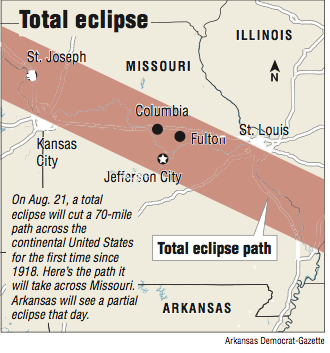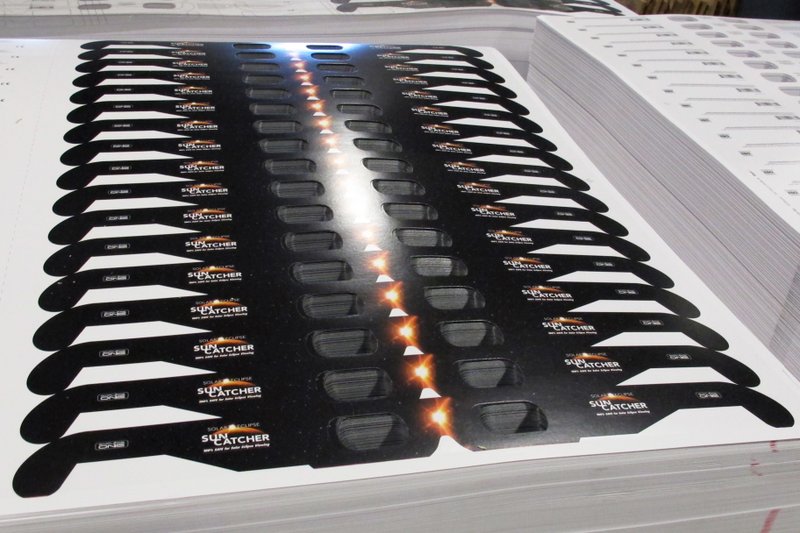The first total solar eclipse to sweep across the United States in almost a century will largely block the sun across all of Arkansas in mid-August as the moon casts a shadow on the state.
A total solar eclipse will pass along a thin strip of land that stretches from the northern West Coast to the southern East Coast on Aug. 21, according to current projections. During a total eclipse, the moon directly overlaps the sun and turns the day almost as dark as night.
Because the moon, sun and Earth do not align perfectly for most of the country, Arkansans will experience a partial eclipse. Most, though not all, of the sun will be obscured, according to the eclipse forecasting website timeanddate.com.
“From our perspective, this looks like the Moon has taken a bite out of the Sun,” the website says.

Eclipse observers in central Arkansas will notice a sizable bite. From Little Rock's perspective, the moon will start to edge in front of the sun at 11:47 a.m., forecasters predict. At 1:18 p.m., most of the sun’s face, about 90 percent, will be concealed. By 2:46 p.m., the moon will have moved on. During this time, the outer section of the moon's shadow, the penumbra, will shade the state.
The last total eclipse to cross the country from coast to coast was June 8, 1918, according to NASA. The Arkansas Gazette reported that despite some cloudiness, the effects of the eclipse “were startling.”
“Automobilists switched on their headlights. Lightning bugs quickly roused from the grass and scattered abroad. ... Calf bleatings were answered by the low of the cow. To all appearances it was night,” the paper reported.
“The shadow came swiftly so that one could detect its growing darkness. To have not known the cause of this phenomena would have been very disconcerting,” the unnamed reporter wrote.
A total eclipse is only possible because of a “cosmic quirk,” according to NASA’s website. The moon’s diameter is 400 times narrower than the sun’s, but it’s also 400 times closer, so the moon and sun falsely appear as the same size. When they align exactly right, the moon can obscure the sun entirely, thus creating a total eclipse.
It happens once every 12 to 18 months, according to the website. During that time, stargazers are given the rare chance to see the sun’s corona, which appears as “pearly white rays and streamers” that radiate from the disk of the sun.
In Arkansas, where only a partial eclipse is possible, viewers should never look at directly at it without special filters, the Central Arkansas Astronomical Society warns on its website. Those who want to watch the Aug. 21 event need constant eye protection, either by wearing solar glasses or by constructing a pinhole camera with household materials, said Bruce McMath, a self-described "space race baby" and immediate past president of the group.
Or, McMath said, Arkansans could look in the shadows of hedges and shrubs and glance under trees when the time comes. In those shadows, they'll see images of the partial eclipse. The “little gaps” between leaves act like pinhole cameras that project curved outlines of the sun onto the ground below, he said.
When observing eclipses, “you have to be so careful,” said Beverly Longnecker, a member of the Sugar Creek Astronomical Society based in Bella Vista. Longnecker said she and her husband started watching the cosmos when they bought their son a telescope for Christmas a dozen years ago.
They soon upgraded. The one they'll set up in August has a specialty filter for sun-gazing. On that day, Longnecker said, they'll be at the tail end of a road trip. They plan to pull over at a rest stop near St. Joseph, Mo., where almost total darkness is expected, prop up the telescope and let whoever wants to take a peek, she said.
Catherine Anderson, a member of the Bella Vista group as well as an educator who teaches about stars, said her fascination with space started young. As a girl, she remembers her father holding her up to peer through an telescope's eyepiece.
“It was a little telescope, nothing fabulous or anything,” Anderson said. “It just gave me this keen awareness, even as a little child, of the night sky.”
Her fascination lasted. Anderson and her husband are driving their RV up to St. Joseph in August two days early to beat the crowds. They’ll set up two or three telescopes hooked up to cameras that will snap photos, she said.
Anderson, who has never seen a total eclipse, said she’s excited for a phenomenon dubbed “Baily’s beads.” When the moon first brushes the sun, light trickles through its mountains and winks and sparkles “like diamonds,” she said.
Though the entire eclipsing process lasts three hours, it's only safe to look at with the naked eye for mere minutes. There’s a little pressure to capture something so fleeting, Anderson said. But when the time comes, she plans to savor the moment, step back from the telescope and look up.
“From what I’ve heard and what I’ve seen, you’re just in awe,” she said.
